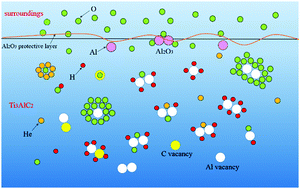First-principles investigation of oxygen interaction with hydrogen/helium/vacancy irradiation defects in Ti3AlC2†
Abstract
First-principles calculations have been performed to investigate the interaction between solute impurity O and H/He/vacancy irradiation defects in Ti3AlC2. The formation energy and occupation of O atoms within different defects as well as the trapping progress of O/H clusters are discussed. It is found that the O atom preferentially occupies the hexahedral interstitial site (Ihex-1) in bulk Ti3AlC2, whereas it prefers to occupy the neighbouring tetrahedral interstitial site (Itetr-2) within pre-exisiting Al monovacancy (VAl), Al divacancy (2VAl–Al) and the 2VAl–C divacancy composed of Al and C vacancies. The appearance of C vacancy could greatly reduce the oxygen formation energy and make an O atom more inclined to occupy the center of C vacancy. Vacancy could capture more O atoms than H/He atoms, where VAl and 2VAl–Al could hold up to fifteen and eighteen O atoms, respectively. Meanwhile, the O could also promote the formation of Al vacancy. On the other hand, O atoms tend to occupy the interstitial sites near the Al atomic layer and have attraction to Al atoms, which is likely to enable the O atoms to combine with the Al atoms to form a Al2O3 protective layer, thus effectively inhibiting further oxidation inside the Ti3AlC2. In addition, the H–O exhibits repulsion interaction, but strong attraction occurs in the He–O interaction. Therefore, the O atom has an inhibitory effect on the formation of the H cluster, while it could bind more He atoms to form a large number of He bubbles. Besides, the O impurity greatly reduces the trapping ability of vacancy to H atoms, and O and He have a synergistic interaction for inhibiting the aggregation of H clusters. The present results are expected to provide a new insight into the behaviour of Ti3AlC2 under irradiation and oxidation conditions so that structural materials could be better designed.



 Please wait while we load your content...
Please wait while we load your content...